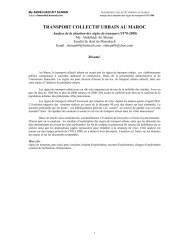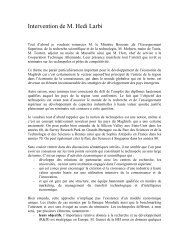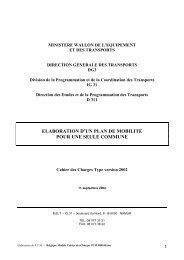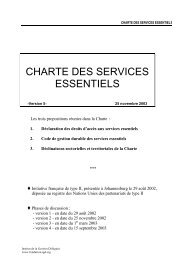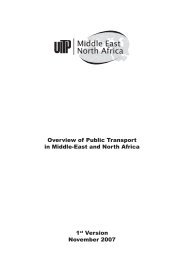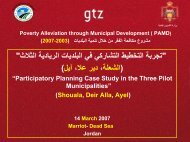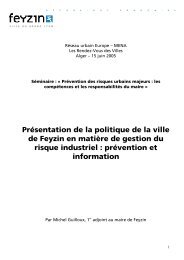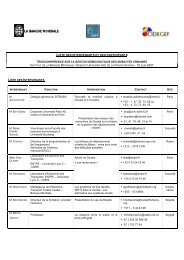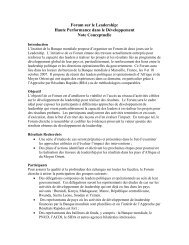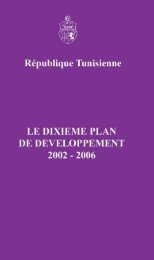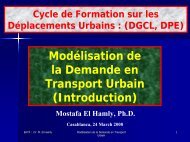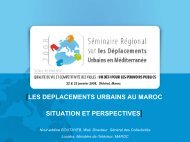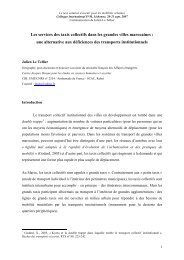Transport Sector Planning in Greater Beirut, Lebanon - Euromedina
Transport Sector Planning in Greater Beirut, Lebanon - Euromedina
Transport Sector Planning in Greater Beirut, Lebanon - Euromedina
Create successful ePaper yourself
Turn your PDF publications into a flip-book with our unique Google optimized e-Paper software.
<strong>Transport</strong> <strong>Sector</strong> <strong>Plann<strong>in</strong>g</strong> <strong>in</strong><strong>Greater</strong> <strong>Beirut</strong>, <strong>Lebanon</strong>Hani MahmassaniUniversity of MarylandTransform<strong>in</strong>g <strong>Transport</strong>ation InstitutionsThe World Bank and WRI/EMBARQWash<strong>in</strong>gton, DC. January 25-26, 2007
Downtown <strong>Beirut</strong>,After the Civil War,mid 1980’s
Rebuild<strong>in</strong>g Downtown:Solidere
BeforeAfter
Downtown <strong>Beirut</strong>,Rebuilt, and morevibrant than ever
1908: Effective and Susta<strong>in</strong>able Public <strong>Transport</strong>ation
Ma<strong>in</strong> forms of transit:Government busesPrivate sector busesJitneys (“service”)
• PROJECTED TRAVEL DEMAND<strong>Greater</strong> <strong>Beirut</strong> AreaPopulation(million)Number of Trips(million)
Integrated Urban <strong>Transport</strong> Project• Traffic Management Component ($25M):– Signal Systems– Video Surveillance– Traffic Management Center• Grade Separation Component ($65M):• Bus System Rehabilitation Component• Park<strong>in</strong>g Component ($5M)
PROPOSED LONG TERM PLAN FOR PUBLIC TRANSITTHREERAILLINESBRT(3 l<strong>in</strong>es)
LONG-TERM ROADNETWORK ADDITIONS
TRANSPORT PLANNING and DECSION-MAKING for GREATER BEIRUT• Fund<strong>in</strong>g controlled at Central Government level (M<strong>in</strong>istry of PublicWorks, for highway projects)• M<strong>in</strong>istry of <strong>Transport</strong> responsibility for policy development,especially re: transit and non-highway modes.• S<strong>in</strong>ce 2002, a transport reform plan has merged the two m<strong>in</strong>istries<strong>in</strong>to a M<strong>in</strong>istry of Public Works and <strong>Transport</strong>, with four directorates:– Directorate General for Land and Maritime <strong>Transport</strong> (DGLMT);responsible for sett<strong>in</strong>g, implement<strong>in</strong>g and supervis<strong>in</strong>g all policiesand regulations related to land and maritime transport.– Directorate General for Civil Aviation (DGCA); responsible for airtransport.– Directorate General for Road and Build<strong>in</strong>gs; responsible for thedesign, construction and ma<strong>in</strong>tenance of <strong>in</strong>ternational, primaryand secondary roads, <strong>in</strong> addition to all government build<strong>in</strong>gs.– Directorate General for Urban <strong>Plann<strong>in</strong>g</strong>, responsible for allregulations related to zon<strong>in</strong>g, land use, build<strong>in</strong>g code, etc.
TRANSPORT PLANNING and DECSION-MAKING for GREATER BEIRUT• Municipality of <strong>Beirut</strong>: weak, no seriousfund<strong>in</strong>g source; other municipalities: ditto• NO MPO-like organization; no formalprocesses for coord<strong>in</strong>ated plann<strong>in</strong>g anddecision-mak<strong>in</strong>g at the metropolitan level(<strong>Greater</strong> <strong>Beirut</strong>)• Police <strong>in</strong> charge of most traffic operations–<strong>in</strong>ternal security forces often also<strong>in</strong>tervene <strong>in</strong> traffic matters.
TRANSPORT PLANNING and DECSION-MAKING for GREATER BEIRUT• Before the civil war, “Council for Projects of<strong>Greater</strong> <strong>Beirut</strong>” was set up as a quasi-plann<strong>in</strong>gboard for the area; reports directly to CentralGovernment (not m<strong>in</strong>istries); no municipal<strong>in</strong>volvement.• After the civil war, it was transformed <strong>in</strong>to the“Council for Development and Reconstruction”(CDR), and became the ma<strong>in</strong> agency <strong>in</strong> chargeof major reconstruction projects, especially<strong>in</strong>volv<strong>in</strong>g external sponsor<strong>in</strong>g agencies orlenders.
ROLE OF CDR(COUNCIL FOR DEVELOPMENTAND RECONSTRUCTION)Secure external f<strong>in</strong>anc<strong>in</strong>gImplement “important share” of projects<strong>Plann<strong>in</strong>g</strong>, programm<strong>in</strong>g and technical supportjo<strong>in</strong>t studies with m<strong>in</strong>istriesfeasibility studies of selected projects(<strong>in</strong>cl. economic benefit, environmental impact, sector studies)
SOURCES OF FUNDING• External fund<strong>in</strong>g• Law 246 (1993)• M<strong>in</strong>istry of Public Works Plan 2001• Other local sourcesPercent local vs. external f<strong>in</strong>anc<strong>in</strong>g of projectsEXTERNALLOCAL
PUBLIC TRANSPORT DECISION-MAKING• Public transport sector has historically lackedcoord<strong>in</strong>ation• Under aegis of M<strong>in</strong>istry of <strong>Transport</strong>, very limitedresources• As part of sector’s restructur<strong>in</strong>g <strong>in</strong> 2002:new <strong>in</strong>dependent body “Office des Chem<strong>in</strong>s deFer et <strong>Transport</strong>s en Commun” (OCFTC)– jo<strong>in</strong>towner and operator of (skeletal) rail system(possibly to be improved) and government’s buspublic transit system; track record rema<strong>in</strong>s to beseen
ALL THE RIGHT WORDS…DRAFT MPWT POLICY STATEMENT IN 2002 (yet to beratified by Cab<strong>in</strong>et)The overall direction of the draft <strong>Transport</strong> Policy is tofoster transport systems which satisfy the follow<strong>in</strong>gobjectives:• Economic and f<strong>in</strong>ancial susta<strong>in</strong>ability• Environmental and ecological susta<strong>in</strong>ability:• Social susta<strong>in</strong>ability
ALL THE RIGHT WORDS… (ctd.)For LAND TRANSPORT• Provid<strong>in</strong>g affordable passenger mobility i.e. land transportnetworks that enable a wide geographic coverage of <strong>Lebanon</strong> atreasonable prices.• Diversify<strong>in</strong>g transport modal choices available to users throughimprov<strong>in</strong>g the public transport quality, reactivat<strong>in</strong>g rail transport,ensur<strong>in</strong>g multi-modality / <strong>in</strong>termodality.• Provid<strong>in</strong>g an efficient and cost-effective <strong>in</strong>ternal goods movementand distribution system <strong>in</strong> urban and rural areas e.g. designatedtruck routes, specific hours of operation, truck standards, etc.• Remov<strong>in</strong>g obstacles that undercut the competitiveness of theLebanese freight transport providers through facilitat<strong>in</strong>g bordercross<strong>in</strong>gs procedures, improv<strong>in</strong>g logistics and <strong>in</strong>ter-modal facilitiesat airports and seaports, etc.
ALL THE RIGHT WORDS… (ctd.)For LAND TRANSPORT (ctd..)• Reduc<strong>in</strong>g the f<strong>in</strong>ancial burden of the transport system on the budgetof <strong>Lebanon</strong> through <strong>in</strong>troduc<strong>in</strong>g the concept of a transport fund and<strong>in</strong>creas<strong>in</strong>g public-private partnership.• Develop<strong>in</strong>g and ma<strong>in</strong>ta<strong>in</strong><strong>in</strong>g high standards of visual beautythroughout the transport <strong>in</strong>frastructure through <strong>in</strong>creased plant<strong>in</strong>g,pleasant landscap<strong>in</strong>g..• Ensur<strong>in</strong>g a high level of safety• Ensur<strong>in</strong>g that environmental and social impacts are well considered<strong>in</strong> all phases of transport projects• Preserv<strong>in</strong>g transport <strong>in</strong>frastructure and protect<strong>in</strong>g transport assetsthrough adequate ma<strong>in</strong>tenance and recurrent rehabilitation of roads.• Build<strong>in</strong>g a world class <strong>in</strong>tellectual and entrepreneurial capability <strong>in</strong>the transport and logistics field.
KEY OBSTACLES and CHALLENGES• “<strong>Greater</strong> <strong>Beirut</strong>” is a geographic entity withoutany organizational or adm<strong>in</strong>istrative structure• No formal coord<strong>in</strong>ation mechanismsadm<strong>in</strong>istratively among the municipalitiesaffected• No mechanism for updat<strong>in</strong>g master plan, or forcont<strong>in</strong>u<strong>in</strong>g comprehensive plann<strong>in</strong>g role• No mechanism for ty<strong>in</strong>g short term projects tolong terms plans• Need for stronger traffic eng<strong>in</strong>eer<strong>in</strong>g at the locallevel
In clos<strong>in</strong>g• “<strong>Beirut</strong>'s recent history - war and reconstruction -lead us to look at the city through the lenses ofexceptionality. But today's plann<strong>in</strong>g agenda (asidentified <strong>in</strong> the National Master Plan by Dar al-Handasah and the IAURIF) has much <strong>in</strong>common with several develop<strong>in</strong>g cities <strong>in</strong> theworld:– uncontrolled urbanization,– environmental damage and– the concentration of urban transportation along thema<strong>in</strong> coastal corridor.”Eric Verdeil @ www.worldviewcities.org
Nevertheless,Great Sunsets



